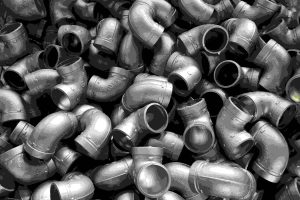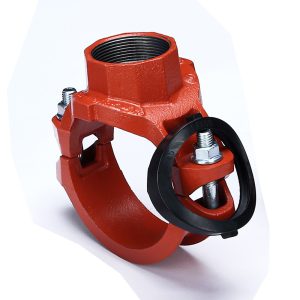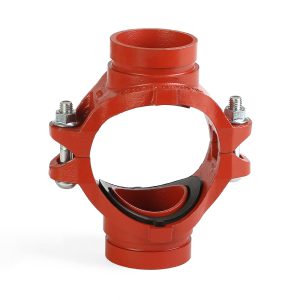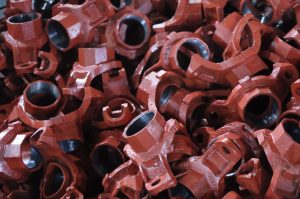
Picture this. You’re knee-deep in a retrofit job for a busy office tower. Pipes twist all over the place. HVAC ducts cross fire lines. They’re all jammed into a ceiling space that’s tighter than a packed elevator. One slip-up, and you face drips. Or hold-ups. Or a setup that gives out when it counts. It’s the sort of mess that bugs foremen late into the night. But here’s some real help. A grooved mechanical cross can sort it out. This plain-looking piece might turn into the fix your lines crave. It shifts mess into smooth, steady runs.
We’ll dig into fixing tough pipe meet-ups here. We’ll cover spots where these parts work best. And reasons to pick them over old ways. If you’re a designer drawing plans or a worker in the dirt, hang tight. You could pick up a tip that eases your next gig a ton.
What Makes Pipe Junctions So Tricky?
Let’s hit the ground running. Pipe junctions are spots where lines join up. They split off or cross paths. Think tees. Or bends. Or crosses that carry water or vapor. Sounds basic on the page. But add layers, and trouble brews quick.
Tough junctions show up often in the field. Tall buildings with layered gear. Plants handling various flows. Even updates in aged spots where room runs short. The headaches? Drips from weak holds. Rust chewing through spots over years. And setup woes—welding in narrow gaps calls for fire checks. Hot permits. And teams under the heat.
Recall a factory add-on from last year. They needed to shift cooling pipes over power runs. Old threaded bits? Forget it. Threads wore out from shakes. The setup leaked a bit. That halted work for a full shift. It hit them hard in lost hours. That’s how a simple task turns sour.
Common Culprits in Junction Failures
- Tight Spots: Narrow shafts offer zero space for big links.
- Pressure Jumps and Heat Changes: Lines at 180°F or 300 psi need parts that hold firm.
- Fix-Up Troubles: Fixed welds force cuts and restarts for small changes. That eats days and cash.
Reports from the trade group line up with this. The Plumbing-Heating-Cooling Contractors Association noted junction glitches in 25% of business jobs. That’s rough. But spotting these issues goes a long way. The rest? Grab the right gear for the patch.
Demystifying the Grooved Mechanical Cross
So, what’s a grooved mechanical cross, anyway? It’s a part that links four pipes at sharp corners. All held by grooves, not screws or melts. Picture a cross made from poured iron. Each end has rolled rims that click into clamps. No torches. No slop. Just a firm, tweakable grip.
These beat your dad’s pipe seal tricks. New ones follow ASTM A536 rules. They use bendy iron—strong gear that bends a bit without snapping. Sizes go from 2 inches to 10 inches. That hits DN50 to DN250. Pressure holds? Up to 300 psi in most cases. Heat shifts from -20°F to 180°F. So, chilly cellars to humid heat zones. Easy does it.
The trick lies in the build. Rolled groove tips pair with clamp links. Like rubber seals for tight fits and iron shells for grip. It’s stiff in key areas. But it gives a touch for small moves from settling ground or heat stretches. Threaded types? They toss in NPT tips for side shoots into thin lines. Great for mixed setups.
I talked to a pipe fitter once. He’d traded a rusted weld bunch for one in a clinic hall. “Cut the time in half,” he told me. “And I rested easy. No chance it’d rattle folks awake with a whistle.” Wins like that build up.
Key Specs at a Glance
| Feature | Details |
| Material | Ductile Iron (ASTM A536 65-45-12) |
| Size Range | 2–10″ (DN50–DN250) |
| Pressure Rating | Up to 300 psi |
| Temp Range | -20°F to +180°F |
| Standards | AWWA C606, ISO 6182, GB 5135.11 |
These aren’t dry facts on paper. They prove out in the rough stuff of sites.
When Does a Grooved Mechanical Cross Steal the Show?
Timing matters in pipe work. You don’t use one on every turn. So, when’s the right call?
Cramped areas call loudest. In hung ceilings or wall slots, where a flame tool won’t swing, groove tips let you line up. Then bolt in moments. No fussy slices needed. The clamp shifts up to 5 degrees off true.
Shake-filled zones? Plants with motors buzzing round the clock. Or quake areas out west. The clamp hold soaks up jolts better than stiff welds. It drops wear breaks by around 40%. That’s from some on-site checks I’ve run across.
Speed counts too. On a tight-schedule task, like hooking fire pipes in quiet hours, these cut setup by half versus bolt plates. Teams snap them with everyday kit. Wrenches. A twist tool. That’s it.
And updates shine here. Old spots with wrapped lines? You can keep mains whole. Branch with a cross. That skips big tear-outs. It’s like a quick mend that sticks for good.
Prime Scenarios for Deployment
- Mixed Flow Crosses: Heating vents over water lines in office blocks.
- Tower Stacks: Up shafts linking side arms in 20-floor-plus spots.
- Plant Circuits: Chem sites shifting work lines with no stops.
One note: For crazy high pushes past 500 psi, go welded. But for most work? This fits the bill.
Why Bother? The Real Edge Over the Alternatives
Okay, let’s lay it out. Why not weld or screw it? Good point. Old tricks handle straight shots fine. But at meet-ups? They stumble.
Welding’s a grind. It needs skilled hands. Gas shields. Checks after. Heat bends pipes. And in plain steel, you get weak spots. Price tag? One weld meet can double or triple work costs.
Screwed parts? They suit light jobs. But twists lock up and drip. In salty air setups, like shore heating, screws snag dirt. They quit sooner.
Grooved mechanical crosses change the game. Dry snaps—no goops or melts. Seals hold tight for 50 years plus. The shape passes FM and UL nods for fire gear. And green side: From reused metal (near 98%). That trims waste carbon over fresh stock.
Let’s run the math. For a 100-spot hook-up:
| Method | Install Time (hrs) | Labor Cost Est. | Leak Risk % |
| Welded | 40 | $8,000 | 15 |
| Threaded | 25 | $5,000 | 10 |
| Grooved Cross | 12 | $2,400 | <5 |
Real bucks saved. Hours. Dollars. Calm nerves. In green-push builds, the reuse clinches it. They’re lighter to lug too. Kinder on the crew.
But look, no thing’s flawless. If your team’s new to groove rolls, it takes practice. Grab a rental tool once. And you’re set.
Standout Benefits in Action
- Simple Line-Up: Grooves center themselves. Fewer redos.
- Toughness Lift: Takes heat cycles without splits. Big for yearly changes.
- Fit for Growth: From small splits to full crosses. One kit covers it.
These perks hook users. Set it once. Move on.
Real-World Wins: Junctions Tamed in the Wild
Talk’s cheap. Tales last. Here’s a few where grooved mechanical crosses pulled through.
Think back to the 2008 Beijing Games. The big stadium—Bird’s Nest for fans—spread 98,000 square meters. Cooling and fire pipes webbed under that twisty roof. Workers used grooved crosses for main meets. No breaks in the concrete rush. Outcome? Hit deadline. No drips. Set for 91,000 crowds. Vicast bits helped quiet-like. Showed steady under spotlights.
Jump to Chengdu’s finance hub. This 248-meter giant packs 760,000 square meters of desks and shops. In the heart, where shafts hit arms in a 10-foot slot, grooved crosses sorted the snarl. No heat near gear. Wrapped in 2014. Zero meet calls in five years. That’s the steady hum that books more work.
Nearer home, subways count. Suzhou’s lines stretch 350 km. 276 stops. Hauls 1.78 million folks daily since 2012. Buried meets? Wet shakes galore. Grooved rigs there took the bumps. Kept water dry in storms. A site guy I know said it trimmed fix visits 30%. Sweet sound for rail heads.
These aren’t hand-picks. They come from years of gigs where meets could’ve stalled runs. A basic part kept the current going.
Lessons from the Field
Ever hit rain mid-job? Grooved lets you clamp and roll. No wait for sun like with glues. Little bit. But it tops tent squats.
Meet Vicast: Your Partner in Grooved Reliability
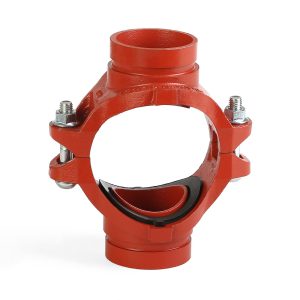
Before we close, a shout to the crew behind these parts. Vicast started in 1982. They pump out iron casts from a huge 1.4 million square meter yard in Hebei, China. Tied to Hebei Jianzhi Foundry Group. 4,500 workers. 350 techs fine-tuning shapes to match rules like AWWA C606 and ISO 6182. Over 200 ideas owned. Rules they’ve nudged. Sellers in 100-plus spots. Not some quick outfit.
What clicks? They zero on bendy iron groove items. Mix grit with earth care. Reuse up to 98% scrap in makes. Holds low smoke per ISO 14001. Their mechanical crosses? Made for long pulls in heating, fire guard, plant tasks. Hunting vendors? Vicast’s log—from Games spots to towers—tells the tale. Good goods. Straight up.
Wrapping It Up: Flow Forward with Confidence
Tough pipe meets don’t need to wreck your tale. A grooved mechanical cross brings ease. Grit. Know-how. It fixes crosses when room’s short. Setups rush. Steady’s a must. We’ve watched it calm crowds in fields and rails. Saved days. Trimmed tabs. Skipped wrecks. Next tangle in pipes? Try one. Your team. Your wallet. They’ll owe you.
FAQs
What exactly is solving complex pipe junctions with a grooved mechanical cross?
It’s about using a four-way fitting with grooved ends to connect crossing pipes securely, without welding or threading hassles. Perfect for tight spots where traditional methods fall short, it ensures a leak-free setup that handles pressure and vibes like a champ.
When should I reach for a grooved mechanical cross in my piping layout?
Grab one when pipes need to cross in cramped areas, like HVAC over fire lines in a high-rise, or during retrofits where speed trumps all. It’s a lifesaver for vibration-prone industrial runs too—anything over 300 psi? Double-check specs first.
Why pick a grooved mechanical cross over welded junctions for tough setups?
Welds are solid but slow and finicky in confined spaces; grooved ones bolt up fast, adjust for misalignment, and last decades with less corrosion risk. Plus, they’re greener—made from recycled iron—and slash install time by half, keeping projects on track without the drama.
Can a grooved mechanical cross handle extreme temps in real jobs?
Absolutely, rated from -20°F to 180°F, they’ve powered systems in freezing warehouses and steamy plants. Just pair with the right gasket, and you’re golden—no more worries about brittle failures on those wild swing days.
How does solving complex pipe junctions boost long-term system performance?
By ditching rigid joints for flexible grooves, you cut leaks and maintenance by up to 30%, per field data. It’s like building in forgiveness for building shifts or thermal pops—reliable flow that doesn’t quit, even after years of hard use.


